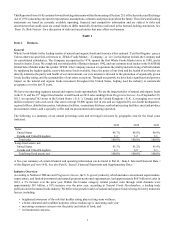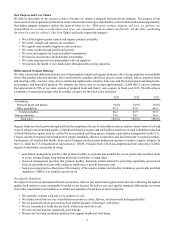Whole Foods 2013 Annual Report Download - page 17
Download and view the complete annual report
Please find page 17 of the 2013 Whole Foods annual report below. You can navigate through the pages in the report by either clicking on the pages listed below, or by using the keyword search tool below to find specific information within the annual report.8
membership clubs, online retailers, smaller specialty stores, farmers’ markets and restaurants, each of which competes with us
on the basis of store ambiance and experience, product selection and quality, customer service, price, convenience or a combination
of these factors.
Marketing
We spend much less on advertising and marketing than other supermarkets – approximately 0.4% of our total sales in fiscal year
2013. Instead, we rely heavily on word-of-mouth advocacy by our shoppers, which we believe is more valuable than traditional
advertising; and we allocate our marketing budgets among various national and regional programs and our individual stores.
We have marketers in every store dedicated to local events, community nonprofits and the best possible in-store experience, and
most of our corporate marketing activity is centered on engaging existing shoppers and growing their basket by introducing
them to a fantastic and unique product selection while constantly increasing their choices. Dollars that would be spent on
traditional media buys are instead typically spent on community nonprofit partnerships that help grow our business and our
communities at the same time. We also connect and engage with our customers through social media, e-newsletters, and our
own website and blog at www.wholefoodsmarket.com.
Social Media
Social media provides us with a powerful way to communicate and interact with our Internet-savvy customers, giving us insight
at both a local and global level as to how we are viewed and what our customers want and expect from us. Company-wide, we
publish roughly 1,000 messages per day across 900 social media channels. Our overall social media footprint on Facebook and
Twitter is approximately 7 million, with 3 million Facebook “likes” and 4 million Twitter followers making us the #2 retail brand
on Twitter. This includes both our global brand accounts and our individual store accounts, which enable us to build deeper
community ties and connect more directly to the tastes and needs of the local customers we serve.
Global Responsibility
We seek to be a deeply responsible company in the communities where we do business around the world, providing ethically
sourced, high-quality products and transparent information to our customers, reducing our impact on the environment, and
actively participating in our local communities. Each store retains a separate budget for making contributions to a variety of
philanthropic and community activities, fostering goodwill and developing a high profile within the community. Our goal is to
contribute at least 5% of our after-tax profits annually to nonprofit organizations.
Healthy Eating Education
We are providing a revolutionary educational program in our stores to promote the health of our customers. Our Health Starts
Here program consists of a simple approach to eating, paired with practical tools and valuable resources, rooted in our four
principles:
• Whole Food: We believe that food in its purest state – unadulterated by artificial additives, sweeteners, colorings, and
preservatives – is the best tasting and most nutritious food available.
• Plant-Strong: No matter what type of diet you follow – including those with dairy, meat and seafood – reconfigure your
plate so the majority of each meal is created from an abundance of raw and cooked vegetables, fruits, legumes and beans,
nuts, seeds and whole grains.
• Healthy Fats: Get healthy fats from whole plant sources, such as nuts, seeds and avocados. These foods are rich in
micronutrients as well. Work to eliminate (or minimize) extracted oils and processed fats.
• Nutrient Dense: Choose foods that are rich in micronutrients when compared to their total caloric content. Micronutrients
include vitamins, minerals, antioxidants and phytochemicals. For guidance, look for the Aggregate Nutrient Density Index
(“ANDI”) scoring system in our stores.
The program includes, among other things: in-store healthy-eating centers to display books and answer questions about healthy
eating and cooking ideas; store tours focused on making healthy eating choices; a wide variety of educational opportunities for
team members; and healthy-eating classes and networking opportunities for our customers. We believe our Health Starts Here
program will grow and evolve over time to become a key competitive advantage for us, and by offering an informed approach
to food as a source for improved health and vitality, we hope to play a big part in the solution to the health care crisis in America,
changing many more lives for the better.
Whole Planet Foundation
Created in 2005, Whole Planet Foundation (www.wholeplanetfoundation.org) is an independent, nonprofit organization whose
mission is to empower the poor through microcredit, with a focus on developing-world communities that supply our stores with
product. Microcredit is a system pioneered by Professor Muhammad Yunus, founder of the Grameen Bank in Bangladesh and
co-recipient of the 2006 Nobel Peace Prize. The philosophy behind microcredit is to provide the poor access to credit without
























